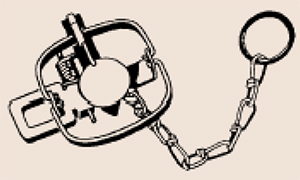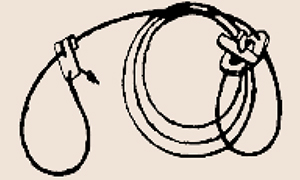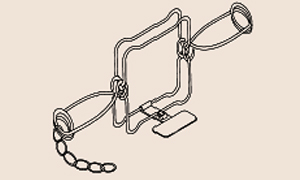Steel-Jaw Leghold Traps
 An archaic device used for centuries, the steel-jaw leghold trap is the most commonly used trap in the United States by commercial and recreational fur trappers. Triggered by a pan-tension device, the weight of an animal stepping between the jaws of the trap causes the jaws to slam shut on the victim’s leg, or other body part, in a vice-like grip.
An archaic device used for centuries, the steel-jaw leghold trap is the most commonly used trap in the United States by commercial and recreational fur trappers. Triggered by a pan-tension device, the weight of an animal stepping between the jaws of the trap causes the jaws to slam shut on the victim’s leg, or other body part, in a vice-like grip.
Most animals react to the instant pain by frantically pulling against the trap in a desperate attempt to free themselves, enduring fractures, ripped tendons, edema, blood loss, amputations, tooth and mouth damage (from chewing and biting at the trap), and starvation.
On land, leghold traps are most frequently set for coyote, bobcat, fox, raccoon, skunk and other furbearing animals. However, leghold traps are inherently indiscriminate and will trap any unsuspecting animal, including dogs and cats, threatened and endangered species, and even humans.
“Padded” Leghold Traps
 Trapping proponents argue that traps used today in the United States are humane, touting the “padded” leghold trap as a commonly used humane alternative to the steel jaw version. However, the only distinctive difference between the two traps is that the padded leghold trap has a thin strip of rubber attached to the trap jaws.
Trapping proponents argue that traps used today in the United States are humane, touting the “padded” leghold trap as a commonly used humane alternative to the steel jaw version. However, the only distinctive difference between the two traps is that the padded leghold trap has a thin strip of rubber attached to the trap jaws.
Not only do these traps cause significant injuries to animals, but research indicates that less than 5 percent of trappers even own padded leghold traps. And numerous studies have shown that padded traps can cause severe injuries to their victims.
Even trappers have admitted that “padded” leghold traps cause severe injuries to animals.
Snare Traps
 Snares are categorized as either body/neck or foot snares. They are generally made of light wire cable looped through a locking device or of a small nylon cord tied so that it will tighten as the animal pulls against it. The more a snared animal struggles, the tighter the noose becomes, the tighter the noose, the greater the animal’s struggle and suffering.
Snares are categorized as either body/neck or foot snares. They are generally made of light wire cable looped through a locking device or of a small nylon cord tied so that it will tighten as the animal pulls against it. The more a snared animal struggles, the tighter the noose becomes, the tighter the noose, the greater the animal’s struggle and suffering.
The body snare is used primarily on coyotes and often is set where animals crawl under a fence or some other narrow passageway. It is designed to kill by strangulation or crushing of vital organs. However, snares do not discriminate and will capture any animal by any body part.
Because they are cheap and easy to set, trappers often will saturate an area with dozens of snares to catch as many animals as possible.
Conibear Traps
 The Conibear trap consists of two metal rectangles hinged together midway on the long side to open and close like scissors. One jaw has a trigger that can be baited. The opposite jaw has a catch or “dog” that holds the trap open.
The Conibear trap consists of two metal rectangles hinged together midway on the long side to open and close like scissors. One jaw has a trigger that can be baited. The opposite jaw has a catch or “dog” that holds the trap open.
Originally intended to be an “instant killing” device, the Conibear trap is designed to snap shut in a scissor-like fashion on an animal’s spinal column at the base of the skull. However, because it is impossible to control the size, species and direction of the animal entering the trap, most animals do not die quickly in the trap, instead enduring prolonged suffering.
Manufactured in three standard sizes, Conibear traps are frequently used in water sets to trap muskrat and beaver. In addition, they are used on land to trap raccoon, pine marten, opossum, and other furbearers. Numerous research studies have shown that this trap does not kill instantly.